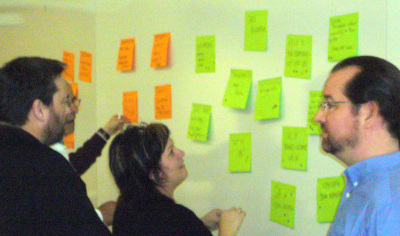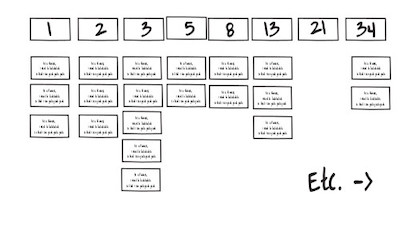Question:
I have been assigned as the PO to a non-development scrum team for product marketing. After one week of work, we have delivered only 2 banner ads from a team of 10 people. The problem seems to be the process of approvals, reviews, kickoffs, briefs, tickets etc that need to happen in order to deliver the work. How would you coach me to help everyone see that our current process could be improved?
Answer:
 My first recommendation is to address this in the team’s retrospective. As product owner, it’s appropriate for you to say you would like to see the team get more ads, or other product backlog items, done in a sprint. Be a bit careful though; it’s very easy for the team to hear that as you blaming them or thinking that they’re not working hard. From the tone of your question, I don’t think that’s where you are coming from, but still be aware they may interpret things that way.
My first recommendation is to address this in the team’s retrospective. As product owner, it’s appropriate for you to say you would like to see the team get more ads, or other product backlog items, done in a sprint. Be a bit careful though; it’s very easy for the team to hear that as you blaming them or thinking that they’re not working hard. From the tone of your question, I don’t think that’s where you are coming from, but still be aware they may interpret things that way.
In the retrospective, you might consider using the GROW model that I’ve been writing about recently. GROW is designed for coaching, but it’s also great for structuring a retrospective. It stands for: Goal, Reality, Options (and Obstacles), and Way Forward. It’s an arc that you, or the scrum master, might guide the team through.
Read the full article…
 Validation is when the facilitator acknowledges the validity of a participant’s position. The facilitator is not necessarily endorsing the viewpoint, but simply recognizing that the viewpoint is reasonable and understandable for the participant to hold.
Validation is when the facilitator acknowledges the validity of a participant’s position. The facilitator is not necessarily endorsing the viewpoint, but simply recognizing that the viewpoint is reasonable and understandable for the participant to hold.
 Writing first is a facilitation technique where participants collect their thoughts in writing before having a discussion. This allows more participation from those that need time to gather their thoughts or feel more comfortable expressing themselves in writing. The facilitator will set a time period for silent writing, then participants share their thoughts once the writing time is up.
Writing first is a facilitation technique where participants collect their thoughts in writing before having a discussion. This allows more participation from those that need time to gather their thoughts or feel more comfortable expressing themselves in writing. The facilitator will set a time period for silent writing, then participants share their thoughts once the writing time is up. Stacking is a facilitation technique which ensures that everyone’s voice is heard. The facilitator acknowledges each person who wants to contribute and establishes an order in which they will share. The result is that each person knows when their turn is and that they won’t be forgotten.
Stacking is a facilitation technique which ensures that everyone’s voice is heard. The facilitator acknowledges each person who wants to contribute and establishes an order in which they will share. The result is that each person knows when their turn is and that they won’t be forgotten. In this third part of our facilitation techniques series, we’re using questions for elaboration to encourage further conversation.
In this third part of our facilitation techniques series, we’re using questions for elaboration to encourage further conversation. In part two of our facilitation techniques series, we’ll practice mirroring: what it is and when to use it for effective facilitation.
In part two of our facilitation techniques series, we’ll practice mirroring: what it is and when to use it for effective facilitation. Looking for techniques for effective facilitation? In this first part of our facilitation techniques series, we’ll dive into paraphrasing: what it is and how to use it.
Looking for techniques for effective facilitation? In this first part of our facilitation techniques series, we’ll dive into paraphrasing: what it is and how to use it. Nominal Group Technique (NGT) is a facilitation tool that helps a group quickly build a comprehensive list of ideas, issues, options or solutions, and then select the best one(s). NGT works faster than traditional brainstorming, yet generates more complete and higher quality results. NGT prevents the quieter voices from being overwhelmed and allows each participant to contribute to their full potential.
Nominal Group Technique (NGT) is a facilitation tool that helps a group quickly build a comprehensive list of ideas, issues, options or solutions, and then select the best one(s). NGT works faster than traditional brainstorming, yet generates more complete and higher quality results. NGT prevents the quieter voices from being overwhelmed and allows each participant to contribute to their full potential.  A scrum team’s definition of done helps them continuously add value to the product and avoid backsliding or breaking things. When a product meets the definition of done, new value is available and the stakeholders can access the value whenever they choose. One way to think about the definition of done, is as a checklist that helps us guarantee the quality of the product.
A scrum team’s definition of done helps them continuously add value to the product and avoid backsliding or breaking things. When a product meets the definition of done, new value is available and the stakeholders can access the value whenever they choose. One way to think about the definition of done, is as a checklist that helps us guarantee the quality of the product. Relative estimation, using story points, has proven itself superior to traditional time-guessing approaches. Common approaches to creating story point estimates, notably
Relative estimation, using story points, has proven itself superior to traditional time-guessing approaches. Common approaches to creating story point estimates, notably  My first recommendation is to address this in the team’s retrospective. As product owner, it’s appropriate for you to say you would like to see the team get more ads, or other product backlog items, done in a sprint. Be a bit careful though; it’s very easy for the team to hear that as you blaming them or thinking that they’re not working hard. From the tone of your question, I don’t think that’s where you are coming from, but still be aware they may interpret things that way.
My first recommendation is to address this in the team’s retrospective. As product owner, it’s appropriate for you to say you would like to see the team get more ads, or other product backlog items, done in a sprint. Be a bit careful though; it’s very easy for the team to hear that as you blaming them or thinking that they’re not working hard. From the tone of your question, I don’t think that’s where you are coming from, but still be aware they may interpret things that way.